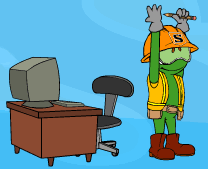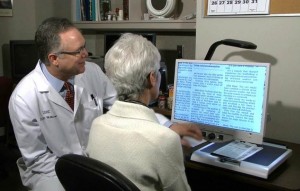When it comes to our health, we may visit our doctors and nurses regularly to make sure our bodies are healthy. But what about our eyes? They’re not always top of mind, but they’re just as important!  May is Healthy Vision Month, an observance coordinated by the National Eye Institute to empower Americans to make their eye health a priority and educate them about steps they can take to protect their vision. What do those steps include?
May is Healthy Vision Month, an observance coordinated by the National Eye Institute to empower Americans to make their eye health a priority and educate them about steps they can take to protect their vision. What do those steps include?
Get a dilated eye exam. When it comes to common vision problems, many people don’t realize their vision could be improved with glasses or contact lenses. In addition, many common eye diseases have no symptoms. A dilated eye exam is the only way to detect these diseases in their early stages.
Live a healthy lifestyle. Almost everything we do affects our eyes. To keep our vision healthy, it is important to:
- Eat healthy foods, especially dark leafy greens such as spinach and kale and fish high in omega-3 fatty acids, including salmon, halibut, and tuna.
- Maintain a healthy weight. Being overweight or obese can increase your risk of developing diabetes and other systemic conditions, which can lead to vision loss.
- Don’t smoke. It’s as bad for your eyes as it is for the rest of your body.
- Manage chronic conditions. Many conditions, including diabetes, hypertension, and multiple sclerosis, can greatly impact vision and result in inflammation of the optic nerve, diabetic retinopathy, glaucoma, and even blindness.
Know your family history. Eye health can be hereditary, so it’s important to talk to your family members about their eye health history. Knowing your family history will help you determine whether you are at higher risk for developing an eye disease.
Use protective eye wear. Eye injuries can happen at work, while playing sports, and when doing chores around the house. Prevent those injuries from happening by wearing protective eyewear! Look for safety glasses, goggles, safety shields, or eye guards made of polycarbonate, which is 10 times stronger than other plastics.
Wear sunglasses. The sun’s rays can damage your eyes, so make sure to wear your shades! When purchasing sunglasses, look for ones that block out 99 to 100 percent of both UVA and UVB radiation.
Celebrate Healthy Vision Month by taking these steps today! Then encourage your family and friends to make their vision a priority by helping NEI spread the word. Here are some ideas:
- Share information on social media using our prewritten content.
- Post NEI’s infocards to your Facebook page and Twitter feed.
- Change your Facebook cover photo to Healthy Vision Month cover photos that highlight steps for taking care of your eyes.
- Post information to your blog. To get started, NEI has a drop-in article you can use.
- Send information through any listservs you’re on or newsletters you have.
- Include Healthy Vision Month Web banners and buttons on your website or blog.
We hope you’ll join in the celebration! And don’t forget to protect your eyes today to see well for a lifetime.
 Susan DeRemer, CFRE
Susan DeRemer, CFRE
Vice President of Development
Discovery Eye Foundation





